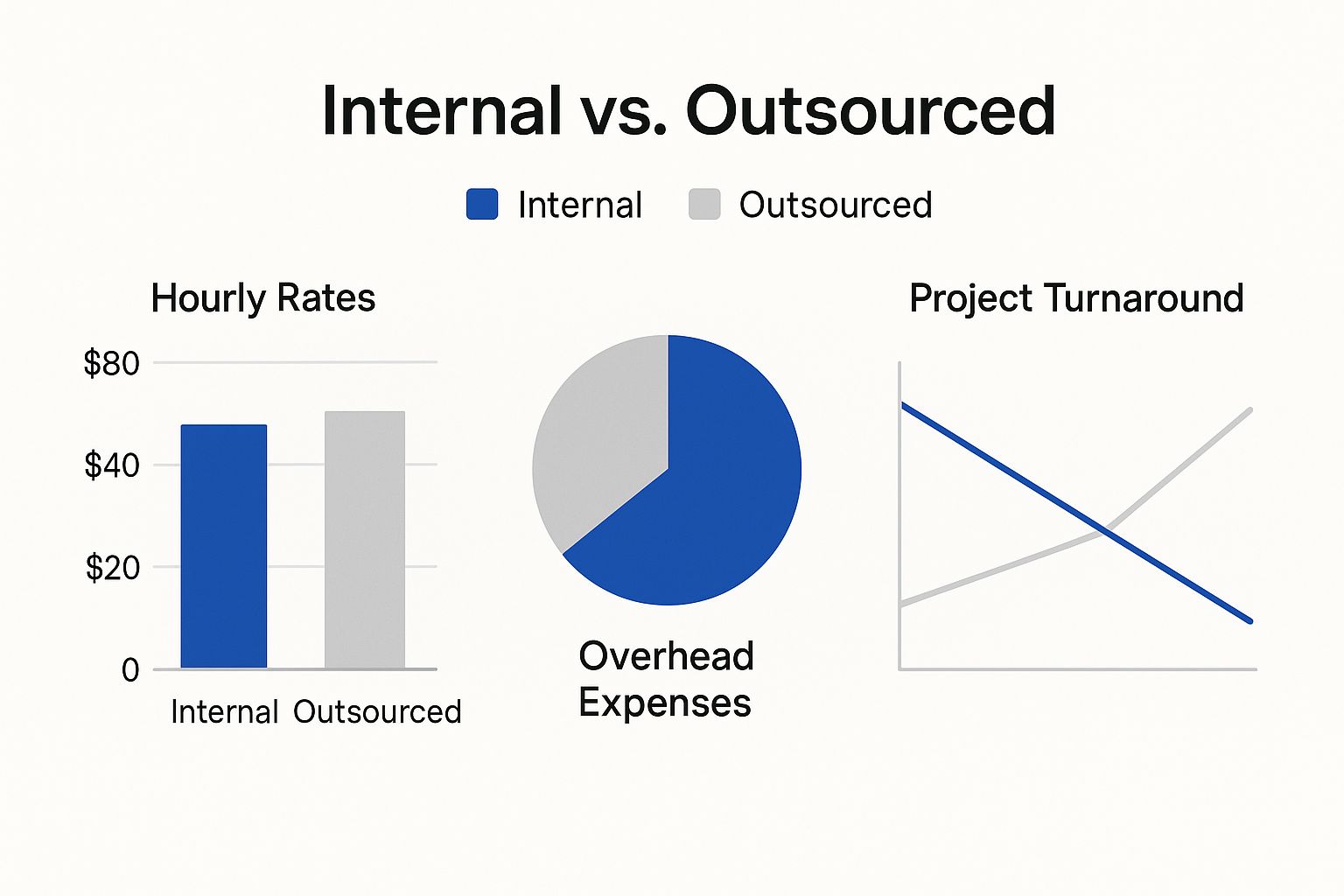For any UK business, the idea of outsourcing can be a game-changer. It’s a strategic move that offers a clear route to cutting costs and bringing in specialist skills, but it's not without its risks. The big trade-off often comes down to losing some direct control and the potential for a dip in quality. Getting this decision right means taking a hard, honest look at both the compelling upsides and the very real downsides.
Weighing the Pros and Cons of Outsourcing
Think of outsourcing as more than just a way to save a few quid; it’s about strategically reallocating your team’s energy to focus on what truly drives the business forward. For many UK SMEs, handing off functions like IT support, accounting, or customer service to outside experts frees up the core team to focus on innovation and growth. It's a way to tap into a global talent pool, often at a much lower cost than hiring someone locally.
And this isn't just a niche trend—it's gathering serious momentum. A striking 57% of UK organisations are apparently planning to outsource more in 2025, mainly to save money and get back to basics. In fact, research points out that 65% of businesses feel the biggest win is simply being able to concentrate on their primary operations again.
Of course, it’s not a one-size-fits-all solution. Before you even consider signing a contract, you need a full picture of the advantages and disadvantages of outsourcing. The benefits can be tempting, but the potential pitfalls need just as much attention.
In-House Versus Outsourcing: A Quick Comparison
To really get your head around the decision, it helps to put the two models side-by-side. This table breaks down the fundamental differences every business leader needs to consider.
Ultimately, the right choice depends entirely on your specific goals, company culture, and how much risk you're comfortable with. To get a better handle on what bringing in external help looks like in practice, it’s worth reading up on specific areas like What is Recruitment Outsourcing? Benefits & Strategies, which can offer some really practical insights.
Exploring the Strategic Advantages of Outsourcing

While everyone talks about cost reduction, the real power of outsourcing lies far deeper. It's about giving your business a genuine strategic edge, not just trimming the budget. For UK SMEs, it unlocks a global talent pool, bringing in specialised skills that are either too expensive or simply not available locally. Suddenly, recruitment isn't a postcode lottery; it's a worldwide search for the best person for the job.
Let's put that into practice. Imagine a growing UK tech start-up that desperately needs top-tier cybersecurity expertise. Competing for the handful of local, highly-paid experts is a tough game. Outsourcing flips the script, giving them instant access to a seasoned professional in another market, often for a fraction of the cost. This isn't just about saving a few quid; it's about acquiring a critical business capability that was previously out of reach.
This kind of strategic thinking is why the Business Process Outsourcing (BPO) market in the UK keeps growing. Between 2020 and 2025, it expanded by about 4.5% to 5.5% each year, with big demand coming from finance and healthcare. The market is tipped to hit roughly £25 billion by 2025, and forecasts suggest it could climb to nearly £26 billion by 2029. It’s clear that UK businesses are catching on, and you can read more about the UK's growing BPO market to see why.
Sharpening Focus on Core Business Functions
One of the most profound benefits I've seen with outsourcing is the clarity it brings to a team. When you hand over essential but non-core functions to a trusted partner, your own people are free to concentrate on what they do best: driving revenue and innovating.
Think about how this plays out in real-world scenarios:
- IT Management: Your internal tech team can stop putting out fires and troubleshooting network glitches. Instead, they can get back to developing that new piece of proprietary software or refining the user experience on your platform.
- Payroll and Accounting: Freeing your finance heads from routine administration means they can focus on high-value work like strategic forecasting, analysing investment opportunities, and building robust business models.
- Customer Support: An outsourced team handling round-the-clock Tier 1 queries lets your core product team focus on development, not answering the same questions over and over again.
By handing over operational necessities to a trusted partner, you're not just delegating tasks—you're strategically redirecting your most valuable resource, your team's time and expertise, towards growth.
Achieving Operational Scalability and Flexibility
Business is never predictable. Demand ebbs and flows. Outsourcing gives you an elastic operational model that can stretch or shrink with the market, but without the headache and cost of hiring and firing permanent staff. That kind of agility is priceless.
A classic example is a retail business gearing up for the Christmas rush. They can easily scale up their customer service team to handle the festive madness and then dial it right back down in January. All of this happens without navigating complex employment laws and procedures.
This flexibility allows a company to jump on opportunities fast and weather downturns without being weighed down by a heavy payroll. It effectively turns a fixed staffing cost into a variable one that’s directly linked to your immediate business needs.
Understanding the Disadvantages and Business Risks

While the benefits of outsourcing can be very appealing, a smart strategy means looking at the potential downsides head-on. If you ignore the risks, what looks like a cost-saving move can quickly become an expensive mistake. The moment you move a business function outside your direct line of sight, you give up a degree of control, and that’s a tough pill to swallow for many business leaders.
This loss of direct oversight is probably the most common worry. When your team is in a different building—or even a different country—you can’t just walk over to their desk to see how things are going or clear up a brief. You end up relying heavily on communication software and formal reports, which don’t always paint the full picture of a project’s health.
As a result, keeping quality consistent can turn into a real challenge. Without someone on your side watching over the day-to-day, there’s always a risk that the outsourced team’s standards won’t quite match yours. This is why having watertight service level agreements (SLAs) and strict quality assurance processes in place from day one is absolutely essential.
Navigating Communication and Cultural Barriers
Good communication is the foundation of any business relationship, but outsourcing adds layers of complexity. Even if your partners are fluent English speakers, small cultural differences and clashing communication styles can easily lead to misunderstandings that hold up projects and cause friction.
These issues are often made worse by practical problems:
- Time Zone Differences: A big time gap can create frustrating bottlenecks. Your in-house team might be stuck waiting for an update from a partner who has already logged off for the day.
- Cultural Nuances: Different workplace cultures can influence everything from how feedback is given to what’s expected of working hours, potentially clashing with your own company’s way of doing things.
- Lack of Integration: It's tough for an outsourced team to ever feel like they are truly part of your company. This can affect how engaged and invested they are in helping you reach your business goals.
Protecting Your Sensitive Information
Handing over business functions usually involves sharing sensitive data—customer details, financial records, intellectual property, you name it. This immediately opens the door to significant security risks. You are essentially trusting a third party with your company's most valuable assets, hoping they take security as seriously as you do.
When you outsource, your data security is only as strong as your provider's weakest link. Thoroughly vetting a partner's security protocols, compliance certifications, and data handling policies is non-negotiable.
This is particularly true for technical roles. For instance, when you look into how to outsource IT services, you must be certain the provider has rock-solid cybersecurity measures to protect your entire digital infrastructure.
Comparing Outsourcing and In-House Teams
Deciding whether to outsource or build your own team isn't a simple choice; there's no universal 'right' answer. The best path really depends on your specific situation – from your current growth stage to the very fabric of your company culture. It boils down to a practical, head-to-head comparison of what matters most to your business.
A clear look at the core differences in cost, control, and scalability will show you which model truly lines up with where you're trying to go.

As you can see, while the outsourced hourly rates are often lower, the real game-changer is the money saved by sidestepping all the hefty overheads that come with permanent employees.
Cost Structures Unpacked
The first thing you’ll notice is the difference in financial commitment. An in-house team is a significant fixed cost. It’s not just about salaries; you’re also on the hook for National Insurance contributions, pension schemes, sick pay, office space, equipment, and ongoing training. These extras can easily pile another 25-40% on top of a basic salary.
Outsourcing, on the other hand, turns these fixed costs into a predictable, variable expense. You pay an agreed-upon fee for the services you need, and the outsourcing partner handles all the associated employment overheads. This makes budgeting far more straightforward and can seriously reduce your overall spend, particularly for specialised roles where local talent comes with a premium price tag.
Take a UK startup needing a financial analyst. Hiring someone in-house could easily top £50,000 a year once you factor in all the overheads. Outsourcing that same role to a vetted professional abroad could potentially slice that cost by more than half, freeing up vital cash for growth.
Control and Oversight
Direct control is often the biggest sticking point for businesses weighing the pros and cons of outsourcing. With an in-house team, you have total oversight. You can walk over to someone's desk for a quick update, get a feel for the team's dynamic, and make immediate adjustments. That proximity gives you a deep, intuitive sense of how a project is progressing.
When you outsource, you're naturally letting go of some of that direct control. Your influence is managed through contracts, Service Level Agreements (SLAs), and scheduled check-ins. While this structured approach can be incredibly efficient, it just doesn't have the immediacy of in-person management.
The trade-off is clear: in-house offers maximum control, while outsourcing demands trust in well-defined processes and solid communication protocols. The key is to implement robust project management systems to maintain visibility and ensure standards are met.
This is exactly why vetting an outsourcing partner so meticulously is non-negotiable. You're not just hiring a skill; you're entrusting them with your workflow and management standards.
For SMEs in the UK, making this decision requires a close look at the trade-offs. The table below breaks down the key factors to help you see which model fits your business needs.
Outsourcing vs In-House: A Head-to-Head Comparison for SMEs
This comparison highlights that the "better" option is entirely situational. It's about weighing the need for control and cultural unity against the desire for cost savings and agility.
Scalability and Agility
Business needs are rarely set in stone, and this is where outsourcing really shines. Scaling an outsourced team is remarkably agile. If you need to double your customer support team for a new product launch or bring on three extra developers for a six-month project, a good partner can make it happen in weeks, not months.
Trying to scale an in-house team is a much slower, more deliberate affair. It’s a marathon of recruitment, onboarding, and training. And if you need to scale back? That’s even more complicated, tangled up in legal issues and team morale. This rigidity can mean missing out on market opportunities or being stuck with a hefty payroll during quiet spells.
Cultural Integration and Team Cohesion
Finally, you have to think about the impact on your company culture. An in-house team is fully immersed in your organisation’s values, your way of communicating, and your overall mission. They are part of the office buzz and build the strong internal relationships that often spark collaboration and new ideas.
Bringing an outsourced professional into the fold takes more conscious effort. While the best partners work hard on cultural alignment, the remote nature of the relationship can still create a sense of distance. Building genuine team spirit requires deliberate action, like including remote members in virtual team events and making sure they're looped into key company communications. If you don't make that effort, an "us versus them" mentality can creep in and get in the way of great work.
Identifying Functions Your Business Should Outsource
Figuring out which parts of your business to hand over to someone else starts with a simple but crucial question: what makes you, you? Every company has its secret sauce—the thing it does better than anyone else. These are your core competencies, and they should stay firmly in-house. Think unique product design, your specific brand voice, or the deep client relationships you've built over years.
Everything else? Those are the operational tasks that keep the lights on but don't directly drive your competitive edge. These non-core functions are often the perfect candidates for outsourcing, as a specialist can usually handle them far more efficiently.
Prime Candidates For Outsourcing
So, where do most businesses start? The best functions to outsource are typically those that are transactional, highly specialised, or just a drain on your internal resources.
A few classic examples come to mind:
- IT Support: This is a big one. Managing servers, keeping on top of cybersecurity threats, and running a helpdesk is a full-time job that demands specialist knowledge.
- Accounting and Bookkeeping: Let's be honest, tasks like payroll, invoicing, and tax prep are critical, but they're also repetitive. Outsourcing ensures everything is accurate and compliant without bogging down your team.
- Customer Service: For handling routine enquiries and support tickets, an external team can be a game-changer, especially if you need to offer 24/7 coverage.
- Digital Marketing: SEO, social media, and content creation are all specialist fields. If this is an area you're exploring, our guide explains how to effectively https://www.beyondhire.co/blog/outsource-digital-marketing.
The real aim here isn't to get rid of problems. It's about strategically placing certain functions into the hands of experts who can do the job better, faster, and more affordably than you ever could. This move frees up your own people to focus on genuine innovation and growth.
A Quick Evaluation Checklist
To spot the right opportunities in your own business, run through these simple questions for any function you're considering:
- Is this task part of our unique value? If the answer is no, it's probably safe to consider outsourcing.
- Does it require a special skill set we don't have? Outsourcing gives you instant access to top-tier expertise without the eye-watering recruitment costs.
- Is the work highly repetitive or administrative? Specialist providers are built for this kind of efficiency.
- Could an external team do this more cost-effectively? Sometimes, a quick cost-benefit analysis makes the decision for you.
For instance, say you decide to outsource your website development. Finding the right partner is absolutely key. This guide on how to find the best website development agency is a great resource for making sure you choose a team that gets both your tech needs and business goals. Answering these questions honestly will quickly show you which tasks are holding your team back from doing their best work.
A Decision Framework for Choosing the Right Model
Making the final call between outsourcing and hiring in-house isn't a simple choice. It demands a structured look at your company's reality—your budget, your circumstances, and where you see yourself in the long run. This isn't about finding a universal "right" answer, but about discovering the best fit for you.
Let's start with the money, and I mean really looking at the money. You need to go beyond just comparing a salary to an agency fee. We’re talking about the Total Cost of Ownership (TCO) for both options.
For an in-house hire, the salary is just the beginning. You have to factor in National Insurance, pension contributions, recruitment agency fees, training, software licences, equipment, and even the cost of a desk. These extras can easily add 25-40% on top of the base salary. An outsourced partner, on the other hand, usually presents a clear, fixed fee, but don't forget to account for your own team's time managing that relationship.
Aligning Your Choice with Strategic Goals
Once you have a clear financial picture, the conversation becomes far more strategic. Think about your company's long-term goals. If you're planning a rapid expansion into a new market, an outsourced team gives you the agility to test the waters without the commitment of permanent staff.
But what if your secret sauce is a unique company culture and deep-seated, proprietary knowledge? In that case, building an in-house team that lives and breathes your brand every day might be the only way to go. Your staffing model needs to be a launchpad for your growth strategy, not an anchor holding it back.
Your choice shouldn't be a short-term fix for a single problem. It should be a strategic decision that reflects where your company is heading over the next three to five years, balancing immediate needs with future scalability.
Evaluating Risk and Implementation
Finally, it's time to get practical and assess the risks. When you outsource, the big risk is picking the wrong partner. If you're considering this path, you'll need to vet potential providers thoroughly. For instance, businesses exploring SEO Outsourcing Services need to know what to look for.
Here are some critical questions to ask any potential partner:
- What are your security protocols for handling our data?
- How do you manage quality control and keep communication lines open?
- What's your process for getting up to speed with our company culture and integrating with our existing team?
With an in-house team, the risks are different. You're facing the challenge of finding the right talent in a competitive market, the time it takes for a new hire to get fully up to speed, and the damage a bad hire can do to team morale. By weighing up these three areas—cost, strategy, and risk—you can make an informed decision that truly serves your business.

